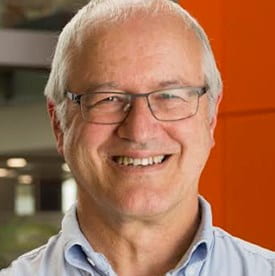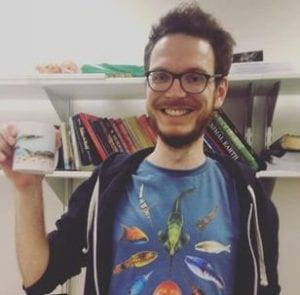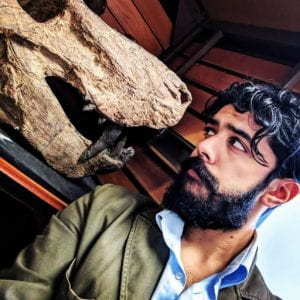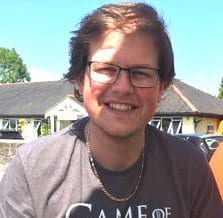 Michael Benton: Mike is interested in the diversification of life through time, quality of the fossil record, shapes of phylogenies, age-clade congruence, mass extinctions, Triassic ecosystem evolution, basal diapsid phylogeny, basal archosaurs and the origin of the dinosaurs. Current research projects focus on the end-Permian mass extinction, dinosaur feathers and colours, and the study of macroevolution using phylogenetic comparative approaches and morphometrics. He also writes textbooks and popular books about dinosaurs and ancient life, and especially the ways in which palaeobiology has transformed itself in the past decades into a hypothetic-deductive science. His role in ERC Innovation is as director.
Michael Benton: Mike is interested in the diversification of life through time, quality of the fossil record, shapes of phylogenies, age-clade congruence, mass extinctions, Triassic ecosystem evolution, basal diapsid phylogeny, basal archosaurs and the origin of the dinosaurs. Current research projects focus on the end-Permian mass extinction, dinosaur feathers and colours, and the study of macroevolution using phylogenetic comparative approaches and morphometrics. He also writes textbooks and popular books about dinosaurs and ancient life, and especially the ways in which palaeobiology has transformed itself in the past decades into a hypothetic-deductive science. His role in ERC Innovation is as director.
 David Button: David is interested in how animals invade novel regions of ecospace, and the interplay of adaptation, organismal constraints, and phylogenetic contingency in shaping patterns of morphological evolution. He has previously combined CT-scanning, virtual reconstruction, morphometric methods, finite-element analysis, and evolutionary modelling to explore dietary evolution within Dinosauria, resolving evolutionary pathways to herbivory and quantifying biomechanical disparity in early dinosaurs. He has also combined these data with estimates of body mass to investigate how feeding ecology underpinned the evolution of gigantism in sauropods, the largest animals to have walked the Earth. David’s role in ERC innovation is to investigate macroevolutionary patterns within birds, synthesising living and fossil data to analyse the diversification of avian clades following the extinction of other dinosaurs at the end of the Mesozoic.
David Button: David is interested in how animals invade novel regions of ecospace, and the interplay of adaptation, organismal constraints, and phylogenetic contingency in shaping patterns of morphological evolution. He has previously combined CT-scanning, virtual reconstruction, morphometric methods, finite-element analysis, and evolutionary modelling to explore dietary evolution within Dinosauria, resolving evolutionary pathways to herbivory and quantifying biomechanical disparity in early dinosaurs. He has also combined these data with estimates of body mass to investigate how feeding ecology underpinned the evolution of gigantism in sauropods, the largest animals to have walked the Earth. David’s role in ERC innovation is to investigate macroevolutionary patterns within birds, synthesising living and fossil data to analyse the diversification of avian clades following the extinction of other dinosaurs at the end of the Mesozoic.
 Joe Keating: Joe is interested in the evolution of morphological complexity and understanding how morphology evolves. He has previously worked on the evolution of the vertebrate skeleton using state-of-the-art synchrotron CT scanning to understand the development and evolution of skeletal tissues in our early vertebrate ancestors. He is also interested in phylogenetic methods for estimating evolutionary trees and reconstructing ancestral conditions using morphology. He has used both simulated and empirical data in order to test the efficacy of Bayesian and parsimony phylogenetic methods. Joe’s role in ERC innovation is to identify, explore and develop accurate methods for modelling the evolution of morphology including complex, linked traits.
Joe Keating: Joe is interested in the evolution of morphological complexity and understanding how morphology evolves. He has previously worked on the evolution of the vertebrate skeleton using state-of-the-art synchrotron CT scanning to understand the development and evolution of skeletal tissues in our early vertebrate ancestors. He is also interested in phylogenetic methods for estimating evolutionary trees and reconstructing ancestral conditions using morphology. He has used both simulated and empirical data in order to test the efficacy of Bayesian and parsimony phylogenetic methods. Joe’s role in ERC innovation is to identify, explore and develop accurate methods for modelling the evolution of morphology including complex, linked traits.
 Benjamin Moon: Ben has spent many years researching marine reptiles such as ichthyosaurs and crocodylians to improve our understanding their evolutionary relationships and palaeoecology. He is particularly interested in how organisms make the most of opportunities and innovations across major transitions, including mass extinction events and evolution of novel adaptations. Ben’s current research involves quantifying ecospace occupation across the end-Permian mass extinction, and how this changed with the invasion of marine reptiles in the Triassic. Ben has used methods from anatomical observation, phylogeny reconstruction, through to CT scan reconstruction and comparative phylogenetics, with increasing interest in method reproducibility and dissemination. See more at Ben’s personal web site.
Benjamin Moon: Ben has spent many years researching marine reptiles such as ichthyosaurs and crocodylians to improve our understanding their evolutionary relationships and palaeoecology. He is particularly interested in how organisms make the most of opportunities and innovations across major transitions, including mass extinction events and evolution of novel adaptations. Ben’s current research involves quantifying ecospace occupation across the end-Permian mass extinction, and how this changed with the invasion of marine reptiles in the Triassic. Ben has used methods from anatomical observation, phylogeny reconstruction, through to CT scan reconstruction and comparative phylogenetics, with increasing interest in method reproducibility and dissemination. See more at Ben’s personal web site.
 Catherine Sheard: Catherine works on macroecology of birds, mammals, and other animals – even languages. She has come from a background working on modern birds and mammals, looking at evolution of aspects of the ecology and behaviour of birds and mammals in particular. Her role in ERC Innovation is to construct a complete phylogeny of mammals, and explore methodological themes around combining modern and fossil taxa, and how modern-only and complete trees document diversification and evolution, as well as exploring trait evolution and expansion of morphospace. Read Catherine’s personal web site.
Catherine Sheard: Catherine works on macroecology of birds, mammals, and other animals – even languages. She has come from a background working on modern birds and mammals, looking at evolution of aspects of the ecology and behaviour of birds and mammals in particular. Her role in ERC Innovation is to construct a complete phylogeny of mammals, and explore methodological themes around combining modern and fossil taxa, and how modern-only and complete trees document diversification and evolution, as well as exploring trait evolution and expansion of morphospace. Read Catherine’s personal web site.
 Suresh Singh: Suresh works on the macroecology of early tetrapods, exploring methods to describe and document the major guilds and how they fared through time. He has defined a number of key roles occupied by Carboniferous to Jurassic tetrapods in terms of specialisations to particular herbivorous and carnivorous diets, and can track the responses of these different portions of the food web to a number of crises, including the end-Permian mass extinction. This time span is especially important for our understanding of the overall drivers of tetrapod diversity because modern clades, including lissamphibians, lepidosaurs, crocodylomorphs, theropods (and birds), and mammals all originated during the Triassic, almost certainly parts of the major restructuring of ecosystems triggered by the end-Permian crisis.
Suresh Singh: Suresh works on the macroecology of early tetrapods, exploring methods to describe and document the major guilds and how they fared through time. He has defined a number of key roles occupied by Carboniferous to Jurassic tetrapods in terms of specialisations to particular herbivorous and carnivorous diets, and can track the responses of these different portions of the food web to a number of crises, including the end-Permian mass extinction. This time span is especially important for our understanding of the overall drivers of tetrapod diversity because modern clades, including lissamphibians, lepidosaurs, crocodylomorphs, theropods (and birds), and mammals all originated during the Triassic, almost certainly parts of the major restructuring of ecosystems triggered by the end-Permian crisis.
 Tom Stubbs: Tom works on morphometrics and macroevolution of vertebrates, extinction events in Earth’s history, shape analyses, the diversification of life through time and numerical methods. He has studied the evolution of marine reptiles, crocodilians, dinosaurs (including birds), fish, and squamates. His first love is the giant marine reptiles of the Mesozoic, but he will work on any tetrapod groups, especially looking at evolution of morphospaces and function. His role in ERC Innovation is to explore the morphospace of all tetrapods living and extinct, and to consider how the filling of morphospace has proceeded, and especially where major clades replace each other, enter entirely new space, and why much of morphospace is unoccupied. Read Tom’s personal web site.
Tom Stubbs: Tom works on morphometrics and macroevolution of vertebrates, extinction events in Earth’s history, shape analyses, the diversification of life through time and numerical methods. He has studied the evolution of marine reptiles, crocodilians, dinosaurs (including birds), fish, and squamates. His first love is the giant marine reptiles of the Mesozoic, but he will work on any tetrapod groups, especially looking at evolution of morphospaces and function. His role in ERC Innovation is to explore the morphospace of all tetrapods living and extinct, and to consider how the filling of morphospace has proceeded, and especially where major clades replace each other, enter entirely new space, and why much of morphospace is unoccupied. Read Tom’s personal web site.

